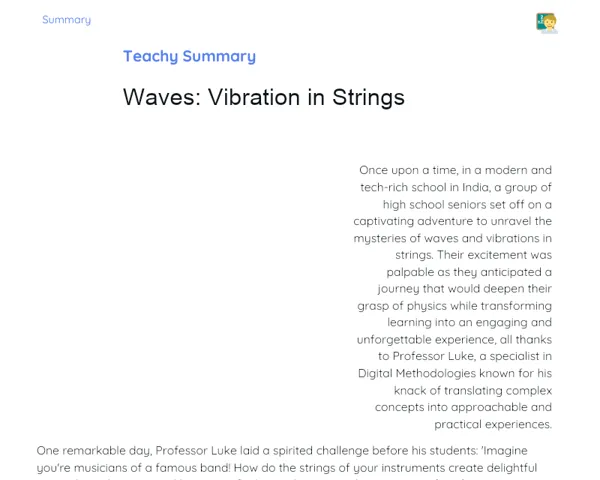Socioemotional Summary Conclusion
Goals
1. Recognize and differentiate between open and closed sound tubes, understanding their physical characteristics and how sound waves behave within them.
2. Understand the concept of vibration in sound tubes under steady-state conditions, relating wavelength to the corresponding harmonic and the tube's length.
Contextualization
Picture yourself at a lively concert, swept away by the grandeur of the symphony. 🎼 As the music envelops you, you might wonder: how do these musical instruments create such beautiful melodies? The answer lies in the vibrations of sound waves within sound tubes! 🌊 Instruments like flutes and clarinets rely on the physical principles we'll explore in this session. Let’s embark on a journey to uncover how sound waves behave and their connection to the music we cherish!
Exercising Your Knowledge
Sound Waves
Sound waves are vibrations that travel through a medium—be it solid, liquid, or gas—and can be perceived by our ears. These waves play a vital role in communication, music, and various daily interactions.
-
Definition of Sound Waves: They are disturbances that move through vibrations in a physical medium.
-
Propagation of Waves: They travel in patterns of compressions and rarefactions, forming areas of high and low pressure.
-
Everyday Examples: Sounds produced by musical instruments or the human voice are prime examples of how sound waves interact with our surroundings.
Sound Tubes
Sound tubes are structures that allow for the formation of standing waves when excited. They can be open or closed, significantly affecting how sound waves behave and the patterns created within them.
-
Open Tubes: These are open at both ends, forming wave patterns with antinodes at each end.
-
Closed Tubes: These have one end closed and one open, forming a node at the closed end and an antinode at the open end.
-
Relevance to Musical Instruments: Instruments like flutes (open tubes) and clarinets (closed tubes) produce sounds using these principles.
Vibration and Harmonics
Vibrations in sound tubes lead to standing waves, showcasing specific patterns called harmonics. These harmonics are closely linked to the tube's length and the wavelength of the sound.
-
Standing Waves: Created when reflected waves overlap with incoming waves, resulting in fixed patterns of nodes and antinodes.
-
Harmonics: These are integer multiples of a standing wave's fundamental frequency, with each harmonic having its own unique pattern of nodes and antinodes.
-
Harmonic Calculation: This involves applying specific formulas for open and closed tubes to determine the resonance frequencies.
Key Terms
-
Sound Waves: Vibrations that traverse a material medium.
-
Sound Tubes: Structures that enable the formation of standing waves.
-
Standing Waves: Vibration patterns formed in a medium consisting of fixed points of nodes and antinodes.
-
Harmonics: Multiple frequencies of the fundamental frequency in standing waves.
For Reflection
-
In what ways do you see the application of vibration concepts in your everyday life? 🧐
-
What emotions surfaced as you delved into the formation of harmonics within sound tubes? 🎶
-
How can understanding sound waves enhance your perception and enjoyment of music? 🎵
Important Conclusions
-
We explored the distinction between open and closed sound tubes and their physical properties.
-
We examined vibrations in sound tubes under steady-state conditions, linking wavelengths to harmonics and tube length.
-
We recognized the significance of studying sound waves and how this knowledge relates to sound production in musical instruments.
Impacts on Society
The behavior of sound waves in tubes greatly influences our daily experiences, particularly in the music we enjoy and perform. Grasping these concepts not only deepens our musical appreciation but also aids those considering pursuits in music or related acoustic fields. Moreover, technologies involving sound transmission, like speakers and microphones, hinge on a thorough understanding of sound waves and their behavior across various media.
Musically, sounds and melodies play a pivotal role in our lives, impacting our mood and well-being. By comprehending how these sounds are generated and altered, we can connect more profoundly with our emotions and our surroundings. The ability to create and modify sounds equips us with a powerful medium to express our feelings and experiences artistically and meaningfully.
Dealing with Emotions
To navigate your emotions while studying sound waves, try this exercise: First, acknowledge your feelings about the content. Are you curious, confused, or excited? Next, identify the source of these emotions. Was it the complexity of the topic or a connection to something you love, such as music? Articulate these emotions clearly (for example: 'I'm curious because I want to learn how music is created'). Express these emotions in a healthy manner—perhaps by discussing with a friend or journaling. Lastly, manage these emotions by finding equilibrium; if you feel overwhelmed, take a short break, and return to your studies with fresh eyes.
Study Tips
-
Utilize online videos and simulations to visualize the behavior of sound waves in various types of tubes. This approach can make the concept more relatable and easier to grasp.
-
Engage with exercises and real-life examples, such as calculating the harmonics of different tubes. This practice will reinforce your understanding of theoretical ideas.
-
Connect personally with the topic: contemplate how these concepts relate to your favorite music and the technology you use in everyday life. This can render studying more engaging and meaningful.


